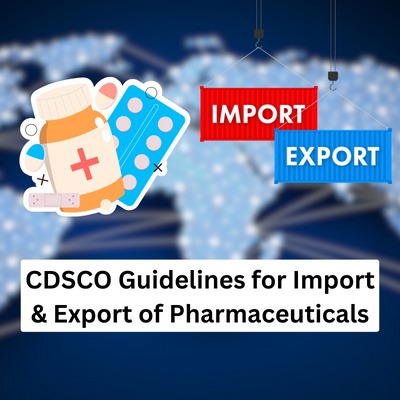

In the dynamic landscape of the pharmaceutical enterprise, the import and export of pharmaceutical products play a pivotal position in ensuring the availability of safe and effective drug treatments internationally. India, as a good-sized contributor to the worldwide pharmaceutical market, operates under the regulatory supervision of the Central Drugs Standard Control Organization (CDSCO).
Understanding and adhering to the CDSCO recommendations for the import and export of pharmaceuticals is crucial for companies engaged in international exchange. This blog “CDSCO Guidelines for Import and Export of Pharmaceuticals” explores the key elements of CDSCO's guidelines, supplying insights into the requirements and exceptional practices that agencies need to navigate efficiently.
Importing pharmaceutical products into India requires compliance with CDSCO regulations to safeguard public health and maintain product quality. Some of the key guidelines for Import of Pharmaceuticals include:
1. A valid import license issued by CDSCO is mandatory for importing pharmaceutical products into India. The license is granted under Form 10 of the Drugs and Cosmetics Rules, 1945.
2. Imported drugs and pharmaceuticals must be registered with CDSCO under Form 41. The registration certificate serves as authorization for the importation of specific pharmaceutical products.
3. Companies engaged in pharmaceutical import activities must obtain an IEC from the Directorate General of Foreign Trade (DGFT). The IEC is a prerequisite for customs clearance and facilitates international trade transactions.
4. Importers are required to submit an authorization letter from the manufacturer or marketing authorization holder (MAH) authorizing them to import specific pharmaceutical products on their behalf.
5. Imported pharmaceutical products must comply with GMP standards established by CDSCO to ensure quality and safety. Manufacturers must provide evidence of GMP compliance through relevant documentation.
6. Imported pharmaceutical products must comply with CDSCO labelling and packaging regulations, including the provision of essential product information in English and adherence to packaging standards.
Here's a list of files required for CDSCO Registration for uploading pharmaceutical products:
Understanding the CDSCO Pharmaceutical Import procedure is essential for pharmaceutical importers seeking to guide the regulatory landscape and ensure compliance with Indian regulations.
Exporting pharmaceutical products from India involves compliance with CDSCO regulations to ensure product quality and safety in international markets. Key export guidelines for Pharmaceuticals include:
1. A valid export license issued by CDSCO is essential for exporting pharmaceutical products from India. The license is granted under Form 10 of the Drugs and Cosmetics Rules, 1945.
2. Pharmaceutical products intended for export must be manufactured in facilities compliant with GMP standards prescribed by CDSCO. Exporters must ensure that manufacturing facilities meet GMP requirements and maintain relevant documentation.
3. Exporters are required to provide a CoA for each batch of pharmaceutical products intended for export. The CoA verifies the quality, purity, and potency of the products and is issued by an accredited laboratory.
4. Exporters must obtain a COPP issued by CDSCO for each pharmaceutical product intended for export. The COPP certifies that the product is manufactured in compliance with Indian regulatory standards.
5. Exporters may be required to provide an FSC issued by CDSCO, attesting that the pharmaceutical product is freely marketed and sold in India without any restrictions.
6. Exporters must classify pharmaceutical products according to HS codes recognized internationally to facilitate customs clearance and trade documentation.
For exporting pharmaceutical merchandise from India and acquiring a CDSCO Certificate, the subsequent files are normally required:
Here we’ve discussed essential points that are followed during the pharmaceutical export:
If you wish to apply online for new Medical Device Import, click HERE
Navigating thе CDSCO Guidelines for Import and Export of Pharmaceuticals is critical for agеnciеs opеrating in thе worldwidе pharmacеutical markеtplacе. By understanding thе complexities of CDSCO's rеgulatory framework, businеssеs can еnsurе thе grеat, safеty, and еfficacy of pharmacеutical products, contributing to thе gеnеral intеgrity of thе industry.





We are the pioneers in offering environmental consulting services to our patrons, giving us the first mover advantage & keeping us ahead of our competitors.
Very experienced in filing, monitoring & submission of CDSCO Compliances, Drugs Manufacturing & sale guidelines, Environmental Impact Assessment, AERB consulting services, Pollution Control Board CTE & CTO Advisory Services, Waste Management Authorization from State Pollution Control Boards, Fertilizers & Insecticides Manufacturing, Wholesale & Import Compliances
